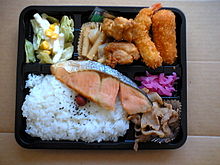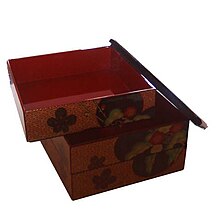Bento: Difference between revisions
FRibeiro66 (talk | contribs) |
Cyberbot II (talk | contribs) Rescuing 1 sources, flagging 0 as dead, and archiving 0 sources. (Peachy 2.0 (alpha 8)) |
||
| Line 42: | Line 42: | ||
[[File:Chicken Teriyaki Bento Ichiban Sushi.jpg|thumb|right|A bento consisting of salmon [[sashimi]], chicken [[teriyaki]] and [[gyoza]], served in a Japanese restaurant in [[Jakarta]].]] |
[[File:Chicken Teriyaki Bento Ichiban Sushi.jpg|thumb|right|A bento consisting of salmon [[sashimi]], chicken [[teriyaki]] and [[gyoza]], served in a Japanese restaurant in [[Jakarta]].]] |
||
[[File:Tōge no Kamameshi 02.jpg|thumb|[[:ja:峠の釜めし|''"Tōge no Kamameshi"'' bento]]]] |
[[File:Tōge no Kamameshi 02.jpg|thumb|[[:ja:峠の釜めし|''"Tōge no Kamameshi"'' bento]]]] |
||
* ''Shōkadō bentō'' ({{lang|ja|松花堂弁当}}) is a traditional black-lacquered [[Japanese people|Japanese]] bento box. It inspired [[IBM]]'s (later sold to [[Lenovo]]) [[ThinkPad]] design.<ref>{{cite news |
* ''Shōkadō bentō'' ({{lang|ja|松花堂弁当}}) is a traditional black-lacquered [[Japanese people|Japanese]] bento box. It inspired [[IBM]]'s (later sold to [[Lenovo]]) [[ThinkPad]] design.<ref>{{cite news|url=http://www.edn.com/article/CA66399.html?partner=eb&pubdate=1%2F1%2F1999 |title=Big Blue's big adventure |first=Peter |last=Golden |publisher=[[EDN (magazine)]] |date=January 1, 1999 |accessdate=2007-03-24 |deadurl=yes |archiveurl=https://web.archive.org/20120620182705/http://www.edn.com/article/CA66399.html?partner=eb&pubdate=1%2F1%2F1999 |archivedate=June 20, 2012 }}</ref> |
||
* ''Chūka bentō'' ({{lang|ja|中華弁当}}) are filled with [[Chinese food]]. While Chinese do have cold plates, it is more for appetizers or midnight "snack". |
* ''Chūka bentō'' ({{lang|ja|中華弁当}}) are filled with [[Chinese food]]. While Chinese do have cold plates, it is more for appetizers or midnight "snack". |
||
* ''Kamameshi bentō'' ({{lang|ja|釜飯弁当}}) are sold at train stations in [[Nagano prefecture]]. It is cooked and served in a [[Clay pot cooking|clay pot]]. The pot is a souvenir item. |
* ''Kamameshi bentō'' ({{lang|ja|釜飯弁当}}) are sold at train stations in [[Nagano prefecture]]. It is cooked and served in a [[Clay pot cooking|clay pot]]. The pot is a souvenir item. |
||
Revision as of 22:37, 29 August 2015



Bento (弁当, bentō)[1] is a single-portion takeout or home-packed meal common in Japanese cuisine. A traditional bento holds rice, fish or meat, with pickled or cooked vegetables, usually in a box-shaped container. Containers range from disposable mass produced to hand crafted lacquerware. Bentos are readily available in many places throughout Japan, including convenience stores, bento shops (弁当屋, bentō-ya), railway stations, and department stores. However, Japanese homemakers often spend time and energy on a carefully prepared lunch box for their spouse, child, or themselves.
Bentos can be elaborately arranged in a style called "kyaraben" ("character bento"). Kyaraben are typically decorated to look like popular characters from Japanese cartoons (anime), comic books (manga), or video games. Another popular bento style is "oekakiben" or "picture bento". This is decorated to look like people, animals, buildings and monuments, or items such as flowers and plants. Contests are often held where bento arrangers compete for the most aesthetically pleasing arrangements.
There are similar forms of boxed lunches in the Philippines (Baon), Korea (Dosirak), Taiwan (Biandang), and India (Tiffin). Also, Hawaiian culture has adopted localized versions of bento featuring local tastes after over a century of Japanese influence in the islands.
Etymology

"Bento" originates from the Southern Song Dynasty slang term 便當 (pinyin: biàndāng), meaning "convenient" or "convenience." When imported to Japan, it was written with the ateji 便道, 辨道, and 辨當.[2] In shinjitai, 辨當 is written as 弁当.
In the 20th century, the term was imported to modern Mandarin, rendered as 便當 (Pinyin biàn-dang), where it retains its older meaning of "convenient" and also refers to bento in mainland China and generic boxed lunches in Taiwan.
History
This section needs additional citations for verification. (August 2006) |




The origin of bento can be traced back to the late Kamakura Period (1185 to 1333), when cooked and dried rice called hoshi-ii (糒 or 干し飯, literally "dried meal") was developed. Hoshi-ii can be eaten as is or boiled with water to make cooked rice, and is stored in a small bag. In the Azuchi-Momoyama Period (1568 to 1600), wooden lacquered boxes like today's were produced and bento would be eaten during a hanami or a tea party.
In the Edo Period (1603 to 1867), bento culture spread and became more refined. Travelers and sightseers would carry a simple koshibentō (腰弁当, "waist bento"), consisting of several onigiri wrapped with bamboo leaves or in a woven bamboo box. One of the most popular styles of bento, called makuno-uchi bentō ("between-act bento"), was first made during this period.[3] People who came to see Noh and Kabuki ate specially prepared bentos between maku (acts). Numerous cookbooks were published detailing how to cook, how to pack, and what to prepare for occasions like Hanami and Hinamatsuri.
In the Meiji Period (1868 to 1912), the first ekibentō or ekiben (駅弁当 or 駅弁, "train station bento") was sold. There are several records that claim where ekiben was first sold, but it is believed that it was sold on 16 July 1885, at the Utsunomiya train station, and contained two onigiri and a serving of takuan wrapped in bamboo leaves. As early schools did not provide lunch, students and teachers carried bentos, as did many employees. "European" style bentos with sandwiches also went on sale during this period.
In the Taishō period (1912 to 1926), the aluminum bento box became a luxury item because of its ease of cleaning and its silver-like appearance. Also, a move to abolish the practice of bento in school became a social issue. Disparities in wealth spread during this period, following an export boom during World War I and subsequent crop failures in the Tohoku region. A bento too often reflected a student's wealth, and many wondered if this had an unfavorable influence on children both physically, from lack of adequate diet, and psychologically, from a clumsily made bento or the richness of food. After World War II, the practice of bringing bentos to school gradually declined and was replaced by uniform food provided for all students and teachers.
Bentos regained popularity in the 1980s, with the help of the microwave oven and the proliferation of convenience stores. In addition, the expensive wood and metal boxes have been replaced at most bento shops with inexpensive, disposable polystyrene boxes. However, even handmade bentos have made a comeback, and they are once again a common, although not universal, sight at Japanese schools. Bentos are still used by workers as a packed lunch, by families on day trips, for school picnics and sports days etc. The bento, made at home, is wrapped in a furoshiki cloth, which acts as both bag and table mat.
The bento made its way to Taiwan in the first half of the 20th century from Japan, and remains very popular to the present day. The Japanese name was borrowed as Bendong (Taiwanese: piān-tong) or Mandarin Biàndang (便當, "convenience pack").
Airports also offer an analogous version of the ekiben: a bento filled with local cuisine, to be eaten while waiting for an airplane or during the flight.[4]
Types



- Shōkadō bentō (松花堂弁当) is a traditional black-lacquered Japanese bento box. It inspired IBM's (later sold to Lenovo) ThinkPad design.[5]
- Chūka bentō (中華弁当) are filled with Chinese food. While Chinese do have cold plates, it is more for appetizers or midnight "snack".
- Kamameshi bentō (釜飯弁当) are sold at train stations in Nagano prefecture. It is cooked and served in a clay pot. The pot is a souvenir item.
- Makunouchi bentō (幕の内弁当) is a classic style of bento with rice, a pickled ume fruit (umeboshi), a slice of broiled salmon, a rolled egg, etc.
- Noriben (海苔弁) is the simplest bento, with nori dipped in soy sauce covering cooked rice.
- Sake bentō (鮭弁当) is a simple bento with a slice of broiled salmon as the main dish.
- Shidashi bentō (仕出し弁当) is made in a restaurant and delivered during lunch. This bento is often eaten at a gathering like a funeral or a party. It is usually packed with traditional Japanese foods like tempura, rice and pickled vegetables. A shidashi bento packed with European-style food is also available.
- Tori bento (鳥弁当) consists of pieces of chicken cooked in sauce served over rice. It is a popular bento in Gunma prefecture.
- Hinomaru bento (日の丸弁当) is the name for a bento consisting of plain white rice with an umeboshi in the centre. The name was taken from the Hinomaru, the Japanese flag, which has a white background with a red circle in the centre. Pure Hinomaru bento only consists of rice and umeboshi to flavor rice without any other side dishes. The metal bento boxes, once popular in Japan, were often corroded by the acid of umeboshi, eventually making a hole in the middle of the lid.
Other
- Hokaben (ホカ弁) is any kind of bento bought at a take-out bento shops. Freshly cooked hot (hokahoka) rice is usually served with freshly prepared side dishes. The name was popularized after a pioneering take-out bento franchise in the field, Hokka Hokka Tei.
- Hayaben (早弁), literally "early bento", is eating a bento before lunch, and having another lunch afterward.
- Ekiben is a bento sold at railway stations (eki) or onboard trains. There are many kinds of ekiben. Most are inexpensive and filling.
- Soraben is a bento sold at airports for eating on an airplane.
In popular culture
- Bento boxes are a major plot element in Bento Monogatari, a 2011 short film by Belgian director Pieter Dirkx.
- The Ben-To series' main theme is about Bento brawls: big, all-out, free for all battles for half-priced bento boxes, where victory is decided by who claims the bento first.
- The Japanese culture and lifestyle television show Begin Japanology aired on NHK World featured a full episode on Bento in 2008.
See also
References
- ^ "Bento". Dictionary.com.
- ^ 弁当(べんとう) 語源由来辞典
- ^ "Japanese Lunch Boxes - History". web-japan.org. Kids Web Japan. Retrieved 9 December 2013.
- ^ Ashkenazi, Michael; Jacob, Jeanne (2001). The essence of Japanese cuisine : an essay on food and culture. Philadelphia: University of Pennsylvania Press. p. 226. ISBN 9780812235661.
- ^ Golden, Peter (January 1, 1999). "Big Blue's big adventure". EDN (magazine). Archived from the original on June 20, 2012. Retrieved 2007-03-24.
{{cite news}}: Unknown parameter|deadurl=ignored (|url-status=suggested) (help)
